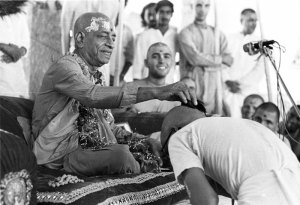Hare Krishna.
23rd September, 2014. Gurgaon
I randomly opened Śrī Caitanya-caritāmṛta yesterday and this beautiful verse, with an enlightening purport by Srila Prabhupada, opened up.
Q : What is the meaning of word Prabhupada ?
Answer:
kāśī-miśra kahe, — āmi baḍa bhāgyavān
mora gṛhe ‘prabhu-pādera’ habe avasthāna (CC Madhya 10.23)
Translation:
When Kāśī Miśra heard the proposal, he said, “I am very fortunate that Śrī Caitanya Mahāprabhu, the Lord of all prabhus, will stay at my home.”
Srila Prabhupada writes in his purport ‘In this verse the word prabhupāda, referring to Śrī Caitanya Mahāprabhu, is significant. Regarding this, Śrīla Bhaktisiddhānta Sarasvatī Gosvāmī Prabhupāda comments, “Śrī Caitanya Mahāprabhu is the Supreme Personality of Godhead Himself, Śrī Kṛṣṇa, and all His servants address Him as Prabhupāda. This means that there are many prabhus taking shelter under His lotus feet.”
The pure Vaiṣṇava is addressed as prabhu, and this address is an etiquette observed between Vaiṣṇavas. When many prabhus remain under the shelter of the lotus feet of another prabhu, the address Prabhupāda is given.
Śrī Nityānanda Prabhu and Śrī Advaita Prabhu are also addressed as Prabhupāda. Śrī Caitanya Mahāprabhu, Śrī Advaita Prabhu and Śrī Nityānanda Prabhu are all viṣṇu-tattva, the Supreme Personality of Godhead, Lord Viṣṇu. Therefore all living entities are under Their lotus feet.
Lord Viṣṇu is the eternal Lord of everyone, and the representative of Lord Viṣṇu is the Lord’s confidential servant. Such a person acts as the spiritual master for neophyte Vaiṣṇavas; therefore the spiritual master is as respectable as Śrī Kṛṣṇa Caitanya or Lord Viṣṇu Himself. For this reason the spiritual master is addressed as Oṁ Viṣṇupāda or Prabhupāda.
The ācārya, the spiritual master, is generally respected by others as Śrīpāda, and the initiated Vaiṣṇavas are addressed as Prabhu. Prabhu, Prabhupāda and Viṣṇupāda are described in revealed scriptures like Śrīmad-Bhāgavatam, Caitanya-caritāmṛta and Caitanya-bhāgavata. In this regard, these scriptures present evidence accepted by unalloyed devotees.’
All glories to Sri Guru and Gauranga.
All glories to Srila Prabhupada.



